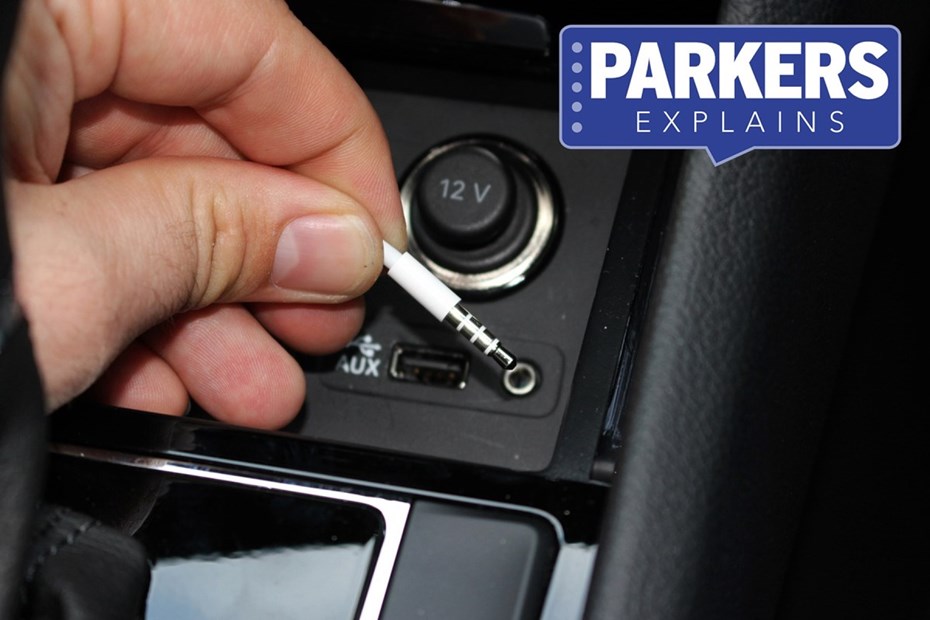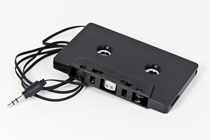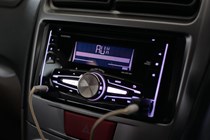Lots of cars feature an aux-in socket (or auxilliary-in, to use its unabridged name) as part of their infotainment system. The socket is for a 3.5mm jack (plug) of the sort that used to be on a set of headphones before everything went wireless. Plug a phone, music player or digital storage device into an aux-in socket and you can listen to your favourite tunes without faffing around trying to connect to the car’s Bluetooth.
Aux-in sockets are being gradually phased out of new cars as manufacturers switch to USB-C and wireless connectivity for Bluetooth and phone mirroring platforms such as Apple CarPlay and Android Auto. For that reason, it’s more likely that you’ll find an aux-in socket in an older, used car.
Here, we’re going to tell you everything you need to know about what an aux-in socket does, how to use it and what to do if your car doesn’t have one.
How does aux-in work?
It’s really easy. Get a cable with a 3.5mm jack then plug it into both the device you want to play audio from and the car’s aux-in socket. The car’s socket is usually in one of three places – the stereo head unit, somewhere on the centre console or under the front centre armrest. There are even a few cars where it’s in the glovebox, for some reason.
Once you’ve connected your device to the car, you may need to press an ‘aux-in’ or ‘media’ button on the stereo. With device and stereo linked, you’re good to go. Simply set the audio playing on the device and listen to the music through the car’s stereo, via the cable.
In some of the latest cars, you should be able to skip between tracks using the infotainment system’s controls. That’s not possible in older cars, though, and the latest rules on using a mobile phone while driving mean you can’t so much as touch your phone or any other device when you’re on the move. Get caught fiddling with a playlist and you could be landed with a hefty fine and points on your license.
It’s better, then, to start a playlist or pick a radio station and stick with it. If you absolutely must handle the device that’s playing audio, pull over in a safe place and turn off the car’s engine before doing so.
What if my car doesn’t have an aux-in socket?
Aux-in sockets started becoming common in cars around 2005, when sales of MP3 players took off. A great many cars built since then have them but, for lots of models, it was only the high-spec trim levels that came with an aux-in as standard.
If your car doesn’t have an aux-in, there are loads of options available to you. The quick and easy solutions cost around £15, while more comprehensive upgrades can cost several hundred pounds.
Let’s start with the most affordable option. If your car has a cassette player, you can get a cassette with a built-in aux-in lead that plugs into your device. They generally only cost a few pounds. You can also get ones with Bluetooth receivers, so you can connect wirelessly. It’s a quick and convenient way to connect, but the sound quality isn’t great. Fun fact: the last brand-new car with a cassette player available in the UK was the 2010 Lexus GS.
If your car’s stereo has a CD player, you’re going to have to change the head unit. That sounds complicated and expensive but, in fact, isn’t. There are a vast number of aftermarket stereos to choose from and the majority of the latest ones have an aux-in port.
A new head unit replaces the whole stereo panel in your car – buttons, screen and all. The old stereo pulls out of the dashboard and the new one slots into its place. There are various cables to connect, and you may need an adaptor or two. If you’re not confident about swapping them over yourself, high-street retailers will do it for you at a small extra cost.
An aftermarket stereo can cost as little £50 for something basic, up to many hundreds for one with all the bells and whistles such as built-in sat-nav and Apple CarPlay and Android Auto connectivity.
Whilst you’re at it, you may as well upgrade your car’s speakers. Again, you don’t have to spend much to get significantly better sound quality, especially if your car is getting on a bit.
My car has aux-in but my phone doesn’t – what can I do?
Fortunately, there’s a very easy and affordable solution here. Just get a cable that has an aux-in jack at one end and a USB plug compatible with your phone at the other. You can buy them for just a couple of pounds, but it’s worth spending at least £20 because the sound quality will be better.
This also applies if you want to play music from a device with an aux-in but the car has a USB socket.













